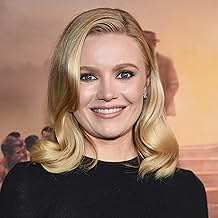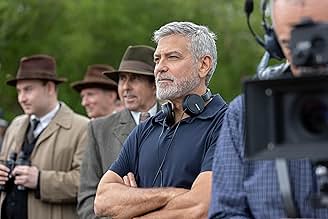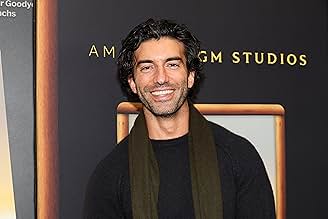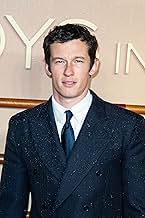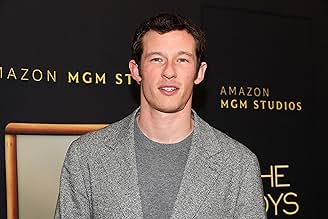Historia ambientada en los años 30 y centrada en el equipo de remo de la Universidad de Washington, desde sus comienzos en la era de la Depresión hasta ganar el oro en los Juegos Olímpicos d... Leer todoHistoria ambientada en los años 30 y centrada en el equipo de remo de la Universidad de Washington, desde sus comienzos en la era de la Depresión hasta ganar el oro en los Juegos Olímpicos de Berlín de 1936.Historia ambientada en los años 30 y centrada en el equipo de remo de la Universidad de Washington, desde sus comienzos en la era de la Depresión hasta ganar el oro en los Juegos Olímpicos de Berlín de 1936.
- Dirección
- Guionistas
- Elenco
- Premios
- 2 premios ganados y 6 nominaciones en total
Tom Varey
- Johnny White
- (as Thomas Stephen Varey)
- Dirección
- Guionistas
- Todo el elenco y el equipo
- Producción, taquilla y más en IMDbPro
Opiniones destacadas
The Boys In The Boat is a cinematic gem that gracefully navigates the waters of history, sportsmanship, and the indomitable human spirit. With a compelling storyline rooted in real-life events, the film effortlessly pulls you into the world of rowing, beautifully capturing the essence of teamwork and resilience. The performances are exceptional, conveying the depth of emotion that accompanies the pursuit of Olympic glory. The cinematography is stunning, making each stroke of the oar a visual spectacle. This is not just a sports movie; it's a heartwarming and inspiring tale that will resonate with audiences of all ages. The Boys in the Boat is a triumph that leaves a lasting impression, celebrating the triumph of the human spirit against all odds.
While The Boys in the Boat is a compelling film, some viewers may find fault in its pacing, as certain moments may feel rushed or unevenly distributed. Additionally, some critics argue that the film, at times, leans heavily on sports movie clichés, potentially making it predictable for those well-versed in the genre.
While The Boys in the Boat is a compelling film, some viewers may find fault in its pacing, as certain moments may feel rushed or unevenly distributed. Additionally, some critics argue that the film, at times, leans heavily on sports movie clichés, potentially making it predictable for those well-versed in the genre.
Boys in the Boat is maybe my favorite nonfiction book of all time. The story of Joe Rantz is inspiring tragic and incredibly easy to root.
The boys in the boat movie captures the beauty of rowing and team work, but it only begins to scratch the surface of the depth of these real life characters.
The biggest flaw in this movie is the writing and at times the dialogue. The writers boil down the tragedies of Joe Rantz and his teammates to simplistic and generic back stories when it would have lead to a more emotional movie to focus on how little these people were given in there life's and how much they were able to accomplish.
While it was still enjoyable and inspiring to watch this classic story, with the material that they had, they should have created a much more emotional and factual film.
I would recommend this movie to anyone but I would highly recommend people read the book.
The boys in the boat movie captures the beauty of rowing and team work, but it only begins to scratch the surface of the depth of these real life characters.
The biggest flaw in this movie is the writing and at times the dialogue. The writers boil down the tragedies of Joe Rantz and his teammates to simplistic and generic back stories when it would have lead to a more emotional movie to focus on how little these people were given in there life's and how much they were able to accomplish.
While it was still enjoyable and inspiring to watch this classic story, with the material that they had, they should have created a much more emotional and factual film.
I would recommend this movie to anyone but I would highly recommend people read the book.
The story is incredible, so I was surprised how flat the movie was. Yes, you get some feel-good moments, but there were so many missed opportunities to make this a truly great movie. The narrative leaves a lot of loose ends that prevent us from connecting with the characters. The actors did their best with what was given, but I really wanted to know more about each character. There were also some shockingly cheesy elements - the intro and ending were completely superfluous, and just lame. The music score was corny and dated. The Boys in the Boat is worth watching once, but if you want the real story, read the book.
Very few people know this story and how incredible this was and honestly the movie didnt even touch on it enough, i know its two hours and what can they do.
Its a family movie that adults will also like the acting is perfect.
Have to give it to Clooney for doing this he had to know this wasn't going to be a huge money maker but did it anyway.
Been waiting for this since i read the fantastic book wondering if someone would pick it up. We need to pay to see these if we want them to be made in the future.
Would have like to have the accomplishments of the rowers show in the credits like the book explained, these were all very successful people, doctors, lawyers and such.
Its a family movie that adults will also like the acting is perfect.
Have to give it to Clooney for doing this he had to know this wasn't going to be a huge money maker but did it anyway.
Been waiting for this since i read the fantastic book wondering if someone would pick it up. We need to pay to see these if we want them to be made in the future.
Would have like to have the accomplishments of the rowers show in the credits like the book explained, these were all very successful people, doctors, lawyers and such.
... Merrily, merrily, merrily,
Life is but a dream ...
A huge bestseller when it was published in 2013, Daniel James Brown's "The Boys in the Boat" was a big hit in my circle of friends. The kind of book that gets recommended, if not passed around, pal to pal.
Set in the '30s it was the true story of the University of Washington junior varsity rowing team who not only gunned down the storied, legacy crews of California and Ivy League colleges, but went on to the 1936 Olympics in Adolf Hitler's Berlin. It was an adrenalized page turner, a movie waiting to happen.
Now that it's getting to the screen, it helps to have George Clooney in the director's chair. Although he stays offscreen, the double-Oscar-winning actor, producer and director is the biggest name on the project.
It's his face - generally recognized as one of the coolest guys on the planet - in many of the production stills and the "for your consideration" ads targeted at industry voters this awards season. George and co-producer Grant Heslov also took part in a recent Zoom press conference for the film along with cast members Joel Edgerton, who stars as taciturn coach Al Ulbrickson; Callum Turner, who plays team member Joe Rantz; and Hadley Robinson, who lights up the screen as Joe's sweetheart, Joyce.
Opening in theaters Christmas Day, it's a feel-good throwback to old-fashioned moviemaking.
Taking place during the Great Depression, the scrappy kids at their oars offered glimpses of optimism and hope, rare commodities in those tough times. Rowing was a popular spectator sport in that pre-ESPN era with spectators lining river banks and in some cases following the action in train cars on the shore keeping pace with the sleek 8-man wooden shells slicing through the water.
Not just an incredibly demanding sport, rowing was a culture, too. The rowing world was made of wood - not just the glossy racing shells, but also their big-doored, high-ceilinged boat houses. You can almost smell the resins and varnish coming from the boathouse surrounded by lush forest on the Seattle campus.
As the team keeps achieving more success, the gorgeous historically recreated settings move, first to colleges on the East Coast before heading for swastika-adorned Germany. Legendary speedster Jesse Owens was another member of the U. S. Olympic team that year. During the press conference Clooney acknowledged borrowing camera angles from Hitler's propagandist Leni Riefenstahl for the climactic Olympic rowing scenes.
"We like to use Nazis whenever we can for filming," he joked.
The mood was light during the Zoom press conference, now that the film was in the can and the cast's arduous training was long past.
London-born actor Turner, whose Joe Rantz is as close as the eight-man team can get to having a hero, acknowledged that he hadn't had any previous rowing experience.
"None of us had actually. And we turn up in February, and we get on the river. And it's snowing. And we're all in the tight shorts and freezing cold and have no skill at being in the boat. And after about three weeks, George and Grant come down to have a look and check in on us. We weren't in a good place. And I could see the pain behind the smile on George's face." "That wasn't pain. That was fear," corrected Heslov.
The boys on the real team hadn't had any experience, either. For Joe and several teammates, making the team - beating the scores of hopefuls for the eight seats (plus the coxswain) - meant getting room and board at the university.
Unlike Ivy Leaguers born to the sport, the junior Huskies were rough hewn. "They were lumberjacks," said Clooney. They came together as a team "out of necessity, out of hunger, out of having nothing else." The actors trained together for five months. Unlike their competitors in the film in new fiberglass shells, their boat, the Huskie Clipper, was made of wood like the original. Beyond just acting, there was a sense of athletic accomplishment for Turner and his teammates.
"The hardest part about rowing is that you all have to be in complete unison," said the actor. "There's no, like, hiding. And if one person is out by a millimeter, the boat suffers." For his part, Clooney faced a different set of challenges.
"The oars are, you know, 15 feet long. And then the boats are 40-some feet long. So, you can't get close to the boats with the camera. And you can't get side by side or ahead of the boats with your camera boat, 'cause you'll capsize the boat. So, we had to come up with a design to get in tight enough to make it exciting. Meaning, we're on an 80-foot arm on the boat with a 300-millimeter lens, 200-millimeter lens, down low, getting wet, trying to hold focus while you're doing that. So, there was a ton of, like, math to try to make those things exciting." On top of that, neither Joe Rantz or Coach Ulbrickson were especially loquacious. They were men of action rather than words. On the printed page this is no big deal. On the big screen it can be. Hadley Robinson's feistiness along with her beauty, and Courtney Henggeler's portrayal of the coach's wife, Hazel, go a long way to humanizing their male partners.
In a key scene, Joe and Joyce share what Clooney called "a 1940s movie kiss" - in a train station, no less. In a way, "The Boys in the Boat" itself is a 1940s movie. It's beautiful to look at, it wears its heart on its sleeve. It comes from an era when wholesome was cool. Standing up and cheering was nothing to be embarrassed by.
But the psychological reserve of its characters played better on the page than they do on the screen.
Despite Clooney's assured direction and the unbreakable spirit of the cast, neither the predictable script nor the soft sentiments of Alexandre Desplat musical score produce the irrepressible "Chariots of Fire" sorts of emotions that spell the difference between good sports movies and great ones.
A huge bestseller when it was published in 2013, Daniel James Brown's "The Boys in the Boat" was a big hit in my circle of friends. The kind of book that gets recommended, if not passed around, pal to pal.
Set in the '30s it was the true story of the University of Washington junior varsity rowing team who not only gunned down the storied, legacy crews of California and Ivy League colleges, but went on to the 1936 Olympics in Adolf Hitler's Berlin. It was an adrenalized page turner, a movie waiting to happen.
Now that it's getting to the screen, it helps to have George Clooney in the director's chair. Although he stays offscreen, the double-Oscar-winning actor, producer and director is the biggest name on the project.
It's his face - generally recognized as one of the coolest guys on the planet - in many of the production stills and the "for your consideration" ads targeted at industry voters this awards season. George and co-producer Grant Heslov also took part in a recent Zoom press conference for the film along with cast members Joel Edgerton, who stars as taciturn coach Al Ulbrickson; Callum Turner, who plays team member Joe Rantz; and Hadley Robinson, who lights up the screen as Joe's sweetheart, Joyce.
Opening in theaters Christmas Day, it's a feel-good throwback to old-fashioned moviemaking.
Taking place during the Great Depression, the scrappy kids at their oars offered glimpses of optimism and hope, rare commodities in those tough times. Rowing was a popular spectator sport in that pre-ESPN era with spectators lining river banks and in some cases following the action in train cars on the shore keeping pace with the sleek 8-man wooden shells slicing through the water.
Not just an incredibly demanding sport, rowing was a culture, too. The rowing world was made of wood - not just the glossy racing shells, but also their big-doored, high-ceilinged boat houses. You can almost smell the resins and varnish coming from the boathouse surrounded by lush forest on the Seattle campus.
As the team keeps achieving more success, the gorgeous historically recreated settings move, first to colleges on the East Coast before heading for swastika-adorned Germany. Legendary speedster Jesse Owens was another member of the U. S. Olympic team that year. During the press conference Clooney acknowledged borrowing camera angles from Hitler's propagandist Leni Riefenstahl for the climactic Olympic rowing scenes.
"We like to use Nazis whenever we can for filming," he joked.
The mood was light during the Zoom press conference, now that the film was in the can and the cast's arduous training was long past.
London-born actor Turner, whose Joe Rantz is as close as the eight-man team can get to having a hero, acknowledged that he hadn't had any previous rowing experience.
"None of us had actually. And we turn up in February, and we get on the river. And it's snowing. And we're all in the tight shorts and freezing cold and have no skill at being in the boat. And after about three weeks, George and Grant come down to have a look and check in on us. We weren't in a good place. And I could see the pain behind the smile on George's face." "That wasn't pain. That was fear," corrected Heslov.
The boys on the real team hadn't had any experience, either. For Joe and several teammates, making the team - beating the scores of hopefuls for the eight seats (plus the coxswain) - meant getting room and board at the university.
Unlike Ivy Leaguers born to the sport, the junior Huskies were rough hewn. "They were lumberjacks," said Clooney. They came together as a team "out of necessity, out of hunger, out of having nothing else." The actors trained together for five months. Unlike their competitors in the film in new fiberglass shells, their boat, the Huskie Clipper, was made of wood like the original. Beyond just acting, there was a sense of athletic accomplishment for Turner and his teammates.
"The hardest part about rowing is that you all have to be in complete unison," said the actor. "There's no, like, hiding. And if one person is out by a millimeter, the boat suffers." For his part, Clooney faced a different set of challenges.
"The oars are, you know, 15 feet long. And then the boats are 40-some feet long. So, you can't get close to the boats with the camera. And you can't get side by side or ahead of the boats with your camera boat, 'cause you'll capsize the boat. So, we had to come up with a design to get in tight enough to make it exciting. Meaning, we're on an 80-foot arm on the boat with a 300-millimeter lens, 200-millimeter lens, down low, getting wet, trying to hold focus while you're doing that. So, there was a ton of, like, math to try to make those things exciting." On top of that, neither Joe Rantz or Coach Ulbrickson were especially loquacious. They were men of action rather than words. On the printed page this is no big deal. On the big screen it can be. Hadley Robinson's feistiness along with her beauty, and Courtney Henggeler's portrayal of the coach's wife, Hazel, go a long way to humanizing their male partners.
In a key scene, Joe and Joyce share what Clooney called "a 1940s movie kiss" - in a train station, no less. In a way, "The Boys in the Boat" itself is a 1940s movie. It's beautiful to look at, it wears its heart on its sleeve. It comes from an era when wholesome was cool. Standing up and cheering was nothing to be embarrassed by.
But the psychological reserve of its characters played better on the page than they do on the screen.
Despite Clooney's assured direction and the unbreakable spirit of the cast, neither the predictable script nor the soft sentiments of Alexandre Desplat musical score produce the irrepressible "Chariots of Fire" sorts of emotions that spell the difference between good sports movies and great ones.
¿Sabías que…?
- TriviaIn a scene during the Olympics, there is mention of Ran Laurie in the British boat. Ran Laurie was the father of actor Hugh Laurie.
- ErroresThe newsreel in the movie says Jesse Owens is from the University of Ohio. While there is an Ohio University in Athens, Ohio, he was actually a student at The Ohio State University --- so named in 1878, well before 1936.
- Citas
German Oarsman: Heil Hitler!
Johnny White: Remember the Alamo!
- ConexionesFeatured in Jimmy Kimmel Live!: George Clooney/Kumail Nanjani/Lenny Kravitz (2023)
- Bandas sonorasUntil Life Turns Your Way Again
Written and Performed by Ian James Donaldson
Courtesy of Black Toast Music
Selecciones populares
Inicia sesión para calificar y agrega a la lista de videos para obtener recomendaciones personalizadas
Detalles
- Fecha de lanzamiento
- País de origen
- Sitio oficial
- Idiomas
- También se conoce como
- The Boys in the Boat
- Locaciones de filmación
- Cleveland Lakes Nature Reserve, Ashton Keynes, Swindon, Wiltshire, Inglaterra, Reino Unido(University of Washington Boathouse, Berlin Olympics)
- Productoras
- Ver más créditos de la compañía en IMDbPro
Taquilla
- Presupuesto
- USD 40,000,000 (estimado)
- Total en EE. UU. y Canadá
- USD 52,641,306
- Fin de semana de estreno en EE. UU. y Canadá
- USD 8,400,548
- 31 dic 2023
- Total a nivel mundial
- USD 55,501,365
- Tiempo de ejecución
- 2h 3min(123 min)
- Color
- Mezcla de sonido
- Relación de aspecto
- 2.39 : 1
Contribuir a esta página
Sugiere una edición o agrega el contenido que falta







